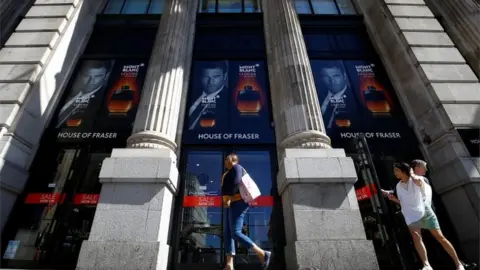House of Fraser: Five things that went wrong
 Reuters
ReutersAfter losing its battle to stay afloat, department store chain House of Fraser has been snapped up by Mike Ashley's Sports Direct.
The move came within hours of the retailer's announcement that it was appointing administrators.
But it is unclear how much of the business will survive.
It's a worrying time for House of Fraser's 17,500 employees, including 11,500 concession staff.
So what went wrong for the retailer?
1. The internet
New technology has had a disruptive influence on the High Street in general, with digital retailers such as Amazon dealing a savage blow to traditional bricks-and-mortar retailers.
But House of Fraser was slow to grasp the extent of the change, failing to respond quickly enough with its own internet offer.
As far back as 2004, the chain was being described by the Interactive Media in Retail Group, a trade body, as one of the "online laggards" that "failed to embrace internet trading opportunities".
It wasn't until last year that it announced a major upgrade of its online platform. By then, sales through the internet had grown to 20% of its business.
However, the £25m that it spent on its digital revamp was just half the amount that online retailer Asos invested in technology in the same year.
Meanwhile, John Lewis outstripped them both with a whopping £500m investment in e-commerce.
2. No USP
Despite the rise of the internet, traditional department stores are not automatically doomed. But people do need a reason to visit them, whether physically or virtually.
Over the years, House of Fraser has gobbled up lots of smaller department store concerns, such as Army & Navy, Dickins & Jones and DH Evans.
In the process, it did a lot to kill off the diversity of High Streets up and down the UK, while failing to replace those defunct brands with a distinctive identity of its own.
As a result, the average House of Fraser store was just that - average. With no unique selling point of its own, it lacked the pulling power it needed to fend off rivals.
Worse still, a lot of the goods sold within were not even House of Fraser's: they were being hawked by more than 600 third-party concession owners. The chain's own brand was taking a back seat.
3. Too many stores
When it embarked on its rescue plan, House of Fraser had 59 department stores in the UK.
That's broadly comparable with John Lewis and a lot less than Debenhams, but those two retailers have been more successful than House of Fraser at reinventing themselves and staying relevant in a crowded marketplace.
Retail analysts reckon the chain should have slimmed down its portfolio a long time ago. Instead, it spent years acquiring more stores, often with expensive legacy lease arrangements.
4. Management and ownership woes
The last 15 years have been a turbulent era for the group: it changed hands twice and became a bid target a number of times.
Amid all the takeovers and fears of takeovers, it was never clear what House of Fraser's long-term strategy was.
The uncertainty began in 2003, when Scottish billionaire Tom Hunter launched an unsuccessful hostile bid.
Other attempted takeovers ensued until in 2006, it was sold to a consortium led by Iceland's Baugur for £351m.
There was yet more takeover talk in 2013, this time with French department store Galeries Lafayette.
A year later, House of Fraser was sold to Chinese department store group Nanjing Xinjiekou, part of Sanpower, in a deal valued at about £480m.
More recently, there's been much talk of a "revolving door" syndrome blighting the chain's management.
When current chief executive Alex Williamson was hired in July last year after nine years at sporting firm Goodwood, his lack of retail experience raised eyebrows.
Mr Williamson's predecessor, Nigel Oddy, had been in the job for less than two years when he resigned in November 2016, leaving the firm rudderless just before the crucial Christmas trading period.
5. No white knight
It was hoped that the company would be rescued by another Chinese company, C.banner, owner of toy store Hamleys. But the deal fell through at the last minute, sealing House of Fraser's fate.
As it turned out, C.banner itself was not robust enough to save the ageing High Street stalwart.
The Hong Kong-listed firm had planned to fund the deal by issuing new shares. But when its share price fell 70% in two months, it was forced to pull the share placing, which it said had become "impracticable and inadvisable".
As a result, there was nothing to stop House of Fraser falling into administration, with Mike Ashley ultimately stepping in to buy up the chain.

